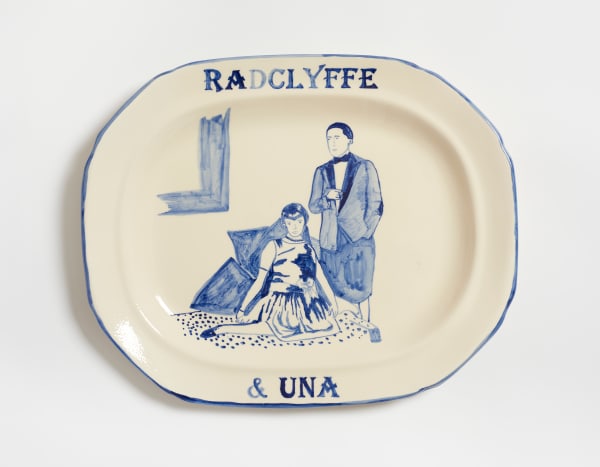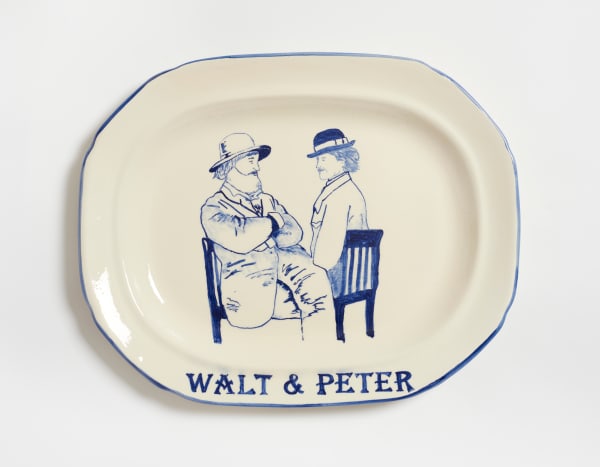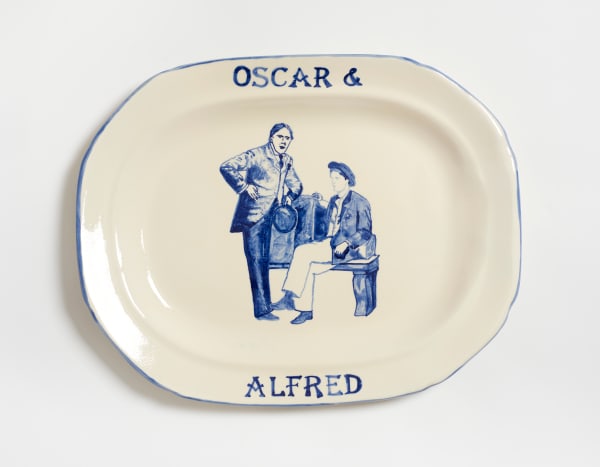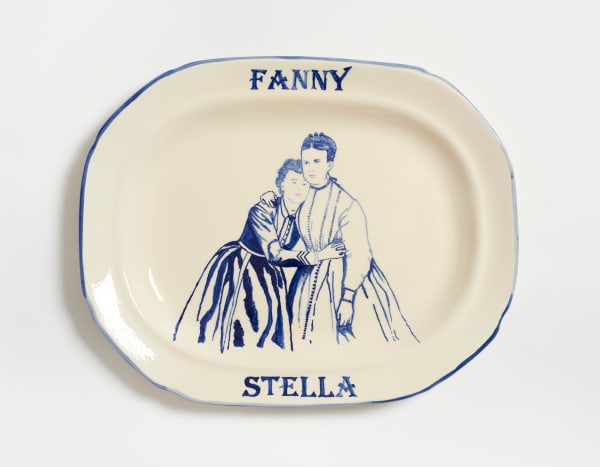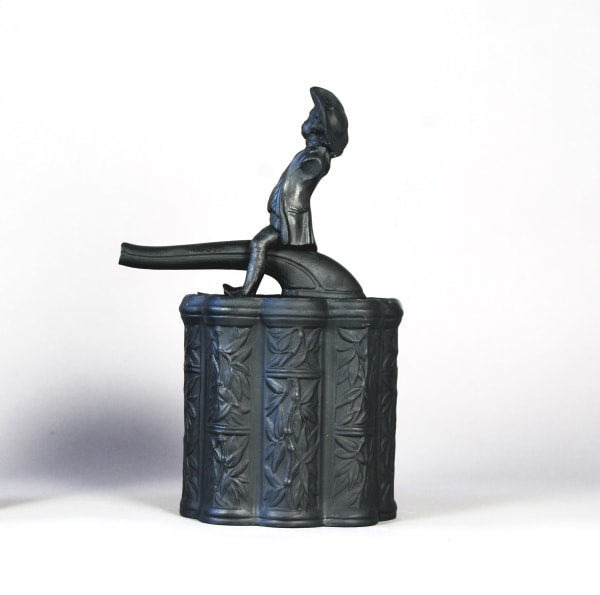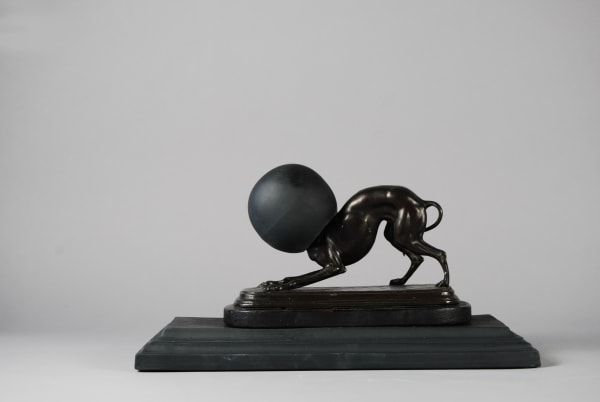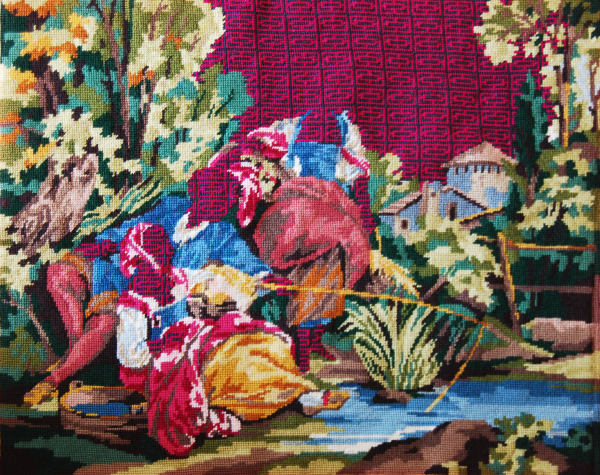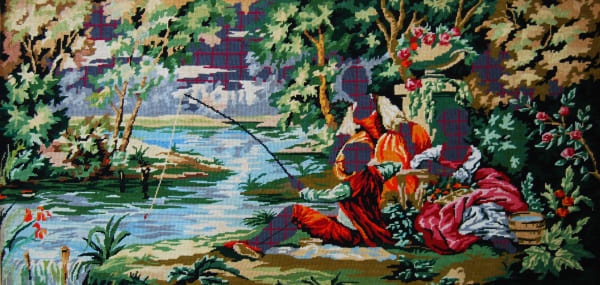-
 Matt Smith (British)Family Romance I, (Claude Cahun), 2024White earthenware, cobalt, glaze40 x 50 x 6 cm
Matt Smith (British)Family Romance I, (Claude Cahun), 2024White earthenware, cobalt, glaze40 x 50 x 6 cm
19 3/4 x 15 3/4 x 2 1/4 in. -
 Matt Smith (British)Family Romance I, (Radclyffe Hall and Una Troubridge), 2024White earthenware, cobalt, glaze40 x 50 x 6 cm
Matt Smith (British)Family Romance I, (Radclyffe Hall and Una Troubridge), 2024White earthenware, cobalt, glaze40 x 50 x 6 cm
19 3/4 x 15 3/4 x 2 1/4 in. -
 Matt Smith (British)Family Romance I, (Eleanor Butler and Sarah Ponsonby), 2024White earthenware, cobalt, glaze40 x 50 x 6 cm
Matt Smith (British)Family Romance I, (Eleanor Butler and Sarah Ponsonby), 2024White earthenware, cobalt, glaze40 x 50 x 6 cm
19 3/4 x 15 3/4 x 2 1/4 in. -
 Matt Smith (British)Family Romance I, (Edward Carpenter and George Merrill), 2024White earthenware, cobalt, glaze40 x 50 x 6 cm
Matt Smith (British)Family Romance I, (Edward Carpenter and George Merrill), 2024White earthenware, cobalt, glaze40 x 50 x 6 cm
19 3/4 x 15 3/4 x 2 1/4 in. -
 Matt Smith (British)Family Romance I, (Walt Whitman and Peter), 2024White earthenware, cobalt, glaze40 x 50 x 6 cm
Matt Smith (British)Family Romance I, (Walt Whitman and Peter), 2024White earthenware, cobalt, glaze40 x 50 x 6 cm
19 3/4 x 15 3/4 x 2 1/4 in. -
 Matt Smith (British)Family Romance I, (Oscar Wilde and Alfred), 2024White earthenware, cobalt, glaze40 x 50 x 6 cm
Matt Smith (British)Family Romance I, (Oscar Wilde and Alfred), 2024White earthenware, cobalt, glaze40 x 50 x 6 cm
19 3/4 x 15 3/4 x 2 1/4 in. -
 Matt Smith (British)Family Romance I, (Fanny and Stella), 2024White earthenware, cobalt, glaze40 x 50 x 6 cm
Matt Smith (British)Family Romance I, (Fanny and Stella), 2024White earthenware, cobalt, glaze40 x 50 x 6 cm
19 3/4 x 15 3/4 x 2 1/4 in. -
 Matt Smith (British)Family Romance I, (Queen Anne and Lady Sarah), 2024White earthenware, cobalt, glaze40 x 50 x 6 cm
Matt Smith (British)Family Romance I, (Queen Anne and Lady Sarah), 2024White earthenware, cobalt, glaze40 x 50 x 6 cm
19 3/4 x 15 3/4 x 2 1/4 in. -
 Matt Smith (British)Move II (Vessel with Venus), 2024White earthenware, underglaze, enamels and lustres30 x 26 x 20 cm
Matt Smith (British)Move II (Vessel with Venus), 2024White earthenware, underglaze, enamels and lustres30 x 26 x 20 cm
10 1/4 x 11 3/4 x 7 3/4 in. -
 Matt Smith (British)Move III (Vessel with Blue Boy), 2024White earthenware, underglaze, enamels and lustres35 x 28 x 28 cm
Matt Smith (British)Move III (Vessel with Blue Boy), 2024White earthenware, underglaze, enamels and lustres35 x 28 x 28 cm
13 3/4 x 11 x 11 in. -
 Matt Smith (British)Move VI (Vessel without feet), 2024White earthenware, underglaze, enamels and lustres34 x 25 x 25 cm
Matt Smith (British)Move VI (Vessel without feet), 2024White earthenware, underglaze, enamels and lustres34 x 25 x 25 cm
13 1/2 x 9 3/4 x 9 3/4 in. -
 Matt Smith (British)Notes from a Love Song (Cannon), 2022Black Parian24 x 17 x 11 cm
Matt Smith (British)Notes from a Love Song (Cannon), 2022Black Parian24 x 17 x 11 cm
9 1/2 x 6 3/4 x 4 1/4 in. -
 Matt Smith (British)Notes from a Love Song (Pedestal), 2022Black Parian22 x 11 x 11 cm
Matt Smith (British)Notes from a Love Song (Pedestal), 2022Black Parian22 x 11 x 11 cm
8 3/4 x 4 1/4 x 4 1/4 in. -
 Matt Smith (British)Notes from a Love Song (Figure on Plinth), 2022Black Parian25 x 13 x 10 cm
Matt Smith (British)Notes from a Love Song (Figure on Plinth), 2022Black Parian25 x 13 x 10 cm
9 3/4 x 5 1/4 x 4 in. -
 Matt Smith (British)After Soldani Benzi (looking right), 2022Black Parian, found spelter figure16 x 30 x 13 cm
Matt Smith (British)After Soldani Benzi (looking right), 2022Black Parian, found spelter figure16 x 30 x 13 cm
6 1/4 x 11 3/4 x 5 1/4 in. -
 Matt Smith (British)After Soldani Benzi (looking left), 2022Black Parian, found spelter figure16 x 30 x 13 cm
Matt Smith (British)After Soldani Benzi (looking left), 2022Black Parian, found spelter figure16 x 30 x 13 cm
6 1/4 x 11 3/4 x 5 1/4 in. -
 Matt Smith (British)The Piper, 2022Black Parian, found porcelain35 x 18 x 10 cm
Matt Smith (British)The Piper, 2022Black Parian, found porcelain35 x 18 x 10 cm
13 3/4 x 7 1/4 x 4 in. -
 Matt Smith (British)Study in Green, 2021Black Parian, Found Ceramic32 x 21 x 11 cm
Matt Smith (British)Study in Green, 2021Black Parian, Found Ceramic32 x 21 x 11 cm
12 1/2 x 8 1/4 x 4 1/4 in. -
 Matt Smith (British)Study in Green with Pearls, 2021Black Parian, Found Ceramic, Freshwater Pearls29 x 14 x 14 cm
Matt Smith (British)Study in Green with Pearls, 2021Black Parian, Found Ceramic, Freshwater Pearls29 x 14 x 14 cm
11 1/2 x 5 1/2 x 5 1/2 in. -
 Matt Smith (British)La Pêche, 2021Reworked textile with wool50 x 65 cm
Matt Smith (British)La Pêche, 2021Reworked textile with wool50 x 65 cm
19 3/4 x 25 5/8 in. -
 Matt Smith (British)Les Pêcheurs, 2020Reworked Textile with Wool52 x 100 cm
Matt Smith (British)Les Pêcheurs, 2020Reworked Textile with Wool52 x 100 cm
20 1/2 x 39 1/4 in.
MATT SMITH
b. 1971, Cambridgeshire, UK
Matt Smith is a multi award-winning artist based in Ireland and England. He is well known for his site-specific work in museums, galleries and historic houses. Using clay, textiles and their associated references, he explores how cultural organisations operate using techniques of institutional critique and artist intervention. Smith is interested in how history is a constantly selected and refined narrative that presents itself as a fixed and accurate account of the past and how, through taking objects and repurposing them in new situations, this can be brought to light. Of particular interest to him is how museums can be reframed into alternative perspectives.
Acclaimed solo exhibitions include Losing Venus at the Pitt Rivers Museum, Flux: Parian Unpacked at the Fitzwilliam Museum, Who Owns History at Hove Museum and Queering the Museum at Birmingham Museum and Art Gallery. In 2015/16 he was artist in residence at the Victoria and Albert Museum in London. He holds a PhD from the University of Brighton and was Professor at Konstfack University, Stockholm.
In 2020 he was awarded the Brookfield Prize at Collect and the Contemporary Art Society acquired a body of his work for Brighton Museum and Art Gallery. His work is also held in the collections of the Victoria and Albert Museum, the Walker Art Gallery, Birmingham Museum and Art Gallery, National Museum of Scotland, National Museum of Northern Ireland and the Crafts Council collection.
Family Romance
Based on a recent installation by the artist 'Untold Lives' at Kensington Palace, and inspired by British royal wedding plates, each of these large meet platters commemorates a queer union.
Queer Family Romance subverts Freud’s idea of family romance and uses object collection and collation to create substitute queer family romances using objects. Whitney Davis, Professor of History of Art at the University of California at Berkeley proposes that queer family romance uses collections of objects to come together to form substitute family groups. Davis suggests that this can work with the collector becoming either an inheritor – placing himself within a group of historical objects or queer biographies – or as a progenitor – creating new links between objects, famously in the case of Horace Walpole and the Walpole Cabinet in the V&A’s collections.
This dinner service is in service to the fragile histories that have been so frequently and easily lost. A branch of my family tree, they are my inheritance.
Claude Cahun (1894 – 1954) was a French surrealist photographer, sculptor, and writer, best known as a writer and self-portraitist, who assumed a variety of performative personae. In her writing she consistently referred to herself as elle (she), [5] and this article follows her practice; but she also said that her actual gender was fluid. Cahun is most well known for her androgynous appearance, which challenged the strict gender roles of her time. During World War II, Cahun was also active as a resistance worker and propagandist.
Queen Anne and Lady Sarah Churchill, Duchess of Marlborough, subjects of the recent film The Favourite.
Radcliffe Hall and Una Troubridge. Hall (1880 – 1943) was an English poet and author, best known for the novel The Well of Loneliness, a groundbreaking work in lesbian literature. In adulthood, Hall often went by the name John, rather than Marguerite.
Oscar Wilde and Lord Alfred Douglas (Bosie). Douglas wrote several books of verse, some in a homoerotic Uranian genre. The phrase "The love that dare not speak its name" appears in one (Two Loves), though it is widely misattributed to Wilde. The two were lovers, and Alfred's father, the Marquess of Queensberry, accused Wilde of being a sodomite. It was Wilde's failed libel action against the Marquess of Queensbury that resulted in Wilde going to Reading Gaol.
Walt Whitman and Peter Doyle. The romance started in 1865 between the streetcar conductor and the poet and spanned the years of Whitman's residence in Washington, D.C, and continued nearly up through Whitman's death in Camden, in 1892.
Eleanor Butler and Sarah Ponsonby. Known as the ladies of Llangollen, Sarah and Eleanor eloped from Ireland in 1780 to escape impending marriages and set up home together in Wales. They became celebrities and guests included Byron, Shelley, Wellington and Wordsworth, the latter of whom wrote a sonnet about them.
Fanny and Stella. Thomas Ernest Boulton and Frederick William Park were Victorian cross-dressers known a Fanny and Stella. Both were gay men from upper-middleclass families, both enjoyed wearing women's clothes and both enjoyed taking part in theatrical performances—playing the women's roles when they did so.
Edward Carpenter and George Merrill. Edward Carpenter (1844 – 1929) was an English utopian socialist, poet, philosopher, anthologist, an early activist for gay rights. An early advocate of sexual liberation, he had an influence on both D. H. Lawrence and Sri Aurobindo, and inspired E. M. Forster's novel Maurice. He met George Merrill, a working-class man in 1891. Merill was 22 years his junior, and the two remained partners for the rest of their lives, cohabiting from 1898
PRESS: 'Untold Lives: a fascinating peek below stairs at a royal palace' - The TelegraphMove
The vessels take The Grand Tour as their starting point. They consider the movement of people, and the ability to move. They provide a container within which to bring with you what you need to survive and thrive, as well as acting as a holding place for the sense of self brought with you from where you came.
Their title refers not only to physical movement, but also the generation of affect - the emotional responses of care and empathy that are needed to create a safe landing when people become displaced.
They draw on ideas of queer temporality - examining queer ways to think about history, space, relationships, notions of success and the need to move out of traditional family situations into new spaces.
A 31 Note Lovesong
Matt Smith developed this series while artist in residence at the Victoria and Albert Museum, A 31 Note Lovesong uses molds from the former Spode ceramics factory in Stoke on Trent and casts from objects in the V&A’s archives. Cast in black parian clay, the works create a portrait of the workers who made the molds, and comment on the silence in the former factory. The juxtaposition of composite objects within the work reflects the arbitrary grouping that occur within museum stores. The work was selected for the British Ceramics Biennial and has been shown at London Design Festival and Gustavsberg Konsthall Stockholm.
Trouble With History
This body of work by Matt Smith is created from a found, vintage, needlepoint which is unpicked and restitched by the artist. Based on paintings by known male artists, the needlepoints were originally produced for amateur, anonymous sewers to stitch. Idealised figures are presented in bucolic settings, their faces replaced by the artist with neutral repeating patterns which disturb the working of the image. By interrupting without substituting a definitive alternative narrative, the work leaves the reinterpretation open for the viewer, questioning the heterosexual constraints of such imagery and prompting a re-consideration of the sitters' skin colour and identity and questioning the viewer’s complacent acceptance of such imagery. Works from the series are held by the V&A, the Crafts Council, Brighton Museum and the National Museum of Northern Ireland.
Matt Smith is a multi award-winning artist based in Ireland and England. Acclaimed solo exhibitions include Losing Venus at the Pitt Rivers Museum, Flux: Parian Unpacked at the Fitzwilliam Museum, Who Owns History at Hove Museum and Queering the Museum at Birmingham Museum and Art Gallery. In 2015/16 he was artist in residence at the Victoria and Albert Museum in London. He holds a PhD from the University of Brighton and was Professor at Konstfack University, Stockholm.
In 2020 he was awarded the Brookfield Prize at Collect and the Contemporary Art Society acquired a body of his work for Brighton Museum and Art Gallery. His work is also held in the collections of the Victoria and Albert Museum, the Walker Art Gallery, Birmingham Museum and Art Gallery, National Museum of Scotland, National Museum of Northern Ireland and the Crafts Council collection.
Matt Smith is represented internationally by Cynthia Corbett Gallery and was the winner of the Young Masters Maylis Grand Ceramics Prize in 2014.

